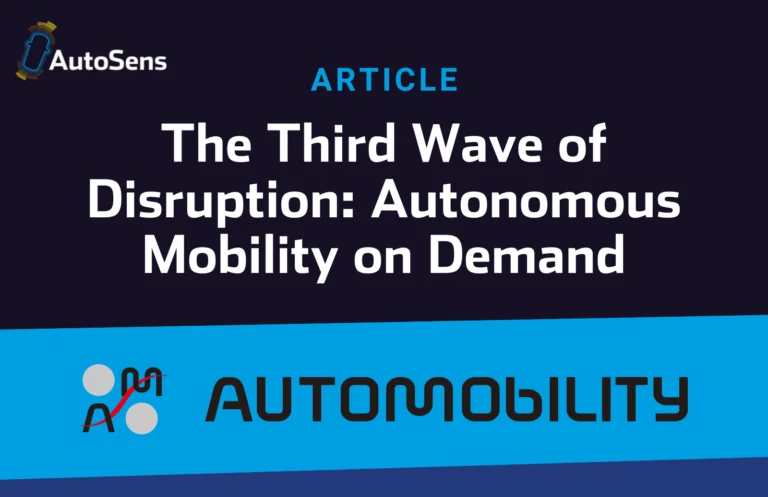
We talk to Tom Miller, General Manager, Regulations & Research at Aisin Technical Center of America. Tom shares with us his view on the regulatory landscape for in-cabin monitoring and new research into its role in vehicle perception. He also discusses the future of ADAS technology and where he sees opportunities for development. Tom will be speaking in November at AutoSens in Detroit on ‘The need to mandate in-cabin monitoring for automated vehicles’.
You are responsible for monitoring critical legislative issues that may affect Aisin business and are speaking on the subject of the regulatory landscape for in-cabin monitoring, is that a complex landscape at the moment? What other legislative issues are you currently keeping an eye on?
We follow all technical related regulations that affect the automotive industry, things like fuel economy, greenhouse gas emissions (related to autos), New Car Assessment Program (NCAP) changes, children left in hot cars, Insurance Institute for Highway Safety (IIHS) 5-Star crash ratings and Top Safety Pick (TSP) changes, Automated Vehicles, V2X, to name some of the top issues. For 2020 we anticipate changes to the fuel economy standards, a long fight between the EPA/NHTSA and CARB, and changes to the IIHS Top Safety Pick and NCAP. Unfortunately, we are not expecting much on automated vehicle legislation or children left in hot cars as these have died in the House and Senate several times already.
You are involved with research related to distracted and drowsy driving and were co-author on a research paper with the National Advanced Driving Simulator at the University of Iowa titled “The Detection of Drowsiness Using a Driver Monitoring System”, what were the main learnings from this research? Are there plans to extend it?
This was a joint project between Aisin Regulation Research and Aisin’s ADAS engineering. I was mostly interested in collecting data and correlating how accurately our Aisin DMS can detect drowsy driving, while they were interested in building on their detection algorithms. We know that distracted and drowsy driving accidents are under reported and one of the leading causes of fatal accidents. I wanted to collect more data to show that DMS does work and can reduce the amount of occurrences. We have used this data to begin discussions with NHTSA as well as Congress and Senate members to educate them on the benefits of the system. Our goal is to teach them about this inexpensive technology that can save lives now. There is room for several suppliers in this market space but it may take regulations to help push it into the market, similar to what’s happening with EuroNCAP. We are extending the research in 2020 with NADS through their SAFER-SIM program. We see this market evolving beyond driver monitoring to complete in-cabin monitoring.
How important for the future safety of automotive do you see in-cabin monitoring becoming a “Guardian Angel” for ADAS systems?
I think it is imperative. We started looking at why fatal accidents in the U.S. went up starting in 2015, overlayed with U.S. cell phone sales which spiked in 2015 as well. I guess it is really no surprise, but as cell phones became more common, more accidents occurred, which the graphs demonstrate nicely. This isn’t a definitive reason for more fatal accidents but it is a large contributing factor. We also looked at IIHS studies that found that lane keep and lane departure systems are ineffective because people were turning them off because they were annoying. A DMS can do the same thing – which is how Aisin’s DMS started. It was first introduced on the Lexus brand in 2006, and was used to pretension the seatbelts and apply the brakes when it detected that they driver was not paying attention and a crash was imminent. It is really just building on that same concept. While you are attentive and operating the vehicle as intended, there is no need to have ADAS active (LKA, LDW, etc.) However, as soon as you look away, reach for something, start getting drowsy, the DMS detects this and turns the ADAS on. So systems like lane departure is only on when you need it, and not turned off because the driver doesn’t like fighting with an annoying system. It’s like having someone watching over you at all times to make sure you are driving safely.
Do you think that it is fair to say that the hype has gone out of autonomous vehicles?
Absolutely, I was hopeful that it would be here sooner, but it is clear that we are a long way away. We have a 2014 Tesla Model S with Autopilot at Aisin and it’s a great car. The autopilot was amazing to experience for the first time but we used it with caution and respect. We, as an industry, realised that automated vehicles are a much more complicated task then originally thought. What is the end goal? Are we pushing AVs to make Uber/LYFT more profitable? Do we really think it will make driving safer? Less congested? Or is it to raise stock prices? The multiple Tesla autopilot crashes have hurt the development of automated vehicles. There have been 13 Tesla crashes using autopilot, which both the NTSB and NHTSA are now closely investigating. The AV START Act failed 3 times in DC. It just keeps piling up. I think we need to take a step back and ask what are we doing it for? Safety? Convenience? Profit? Why are we trying to “run” before we walk, meaning, why don’t we look at slow speed automated vehicles vs high speed. It’s safer and there is a need. Like the Tesla summons feature – if my car can drop me off at the mall entrance then drive away and park itself, that is a convenient feature, especially if its raining, or for handicapped or elderly people. We aren’t ready for cars to travel up to 70+ mph and have to try and detect every possible scenario that could occur. We can’t even figure out V2X and we are going to allow high speed cars to interact. It is really insane. We will figure it out but start smaller and walk before we try to run.
What are you most looking forward to about presenting at AutoSens in Detroit?
I was in product design for 25+ years. Five years ago when they told me I was moving to build our regulations research department at Aisin, I thought that is was going to be boring. I was wrong. I really enjoy looking out into the future and trying to forecast and influence where the technical regulatory landscape is shifting. Strangely, this stuff now excites me. I look forward to trying to convey my passion for trying to change the regulatory direction and get others to help me with this quest. As I said, it isn’t about promoting Aisin products. It is about promoting technology that can save lives or make our lives better. I hope that message comes across and I can continue to build a network of people that want to help by joining the fight.
Find out what other topics are on the agenda for AutoSens in Detroit 2020. View full agenda >>






